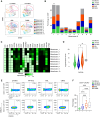Single-Cell Analysis of Bone Marrow CD8+ T Cells in Myeloid Neoplasms Reveals Pathways Associated with Disease Progression and Response to Treatment with Azacitidine
- PMID: 39485042
- PMCID: PMC11616010
- DOI: 10.1158/2767-9764.CRC-24-0310
Single-Cell Analysis of Bone Marrow CD8+ T Cells in Myeloid Neoplasms Reveals Pathways Associated with Disease Progression and Response to Treatment with Azacitidine
Abstract
Abstract: CD8+ T cells are crucial for antitumor immunity. However, their functionality is often altered in higher-risk myelodysplastic neoplasms (MDS) and acute myeloid leukemia (AML). To understand their role in disease progression, we conducted a comprehensive immunophenotypic analysis of 104 pretreatment bone marrow (BM) samples using mass and flow cytometry. Our findings revealed an increased frequency of CD57+CXCR3+ subset of CD8+ T cells in patients who did not respond to azacitidine (AZA) therapy. Furthermore, an increased baseline frequency (>29%) of the CD57+CXCR3+CD8+ T-cell subset was correlated with poor overall survival. We performed single-cell RNA sequencing to assess the transcriptional profile of BM CD8+ T cells from treatment-naïve patients. The response to AZA was linked to an enrichment of IFN-mediated pathways, whereas nonresponders exhibited a heightened TGF-β signaling signature. These findings suggest that combining AZA with TGF-β signaling inhibitors targeting CD8+ T cells could be a promising therapeutic strategy for patients with higher-risk MDS and AML.
Significance: Immunophenotypic analysis identified a BM CD57+CXCR3+ subset of CD8+ T cells associated with response to AZA in patients with MDS and AML. Single-cell RNA sequencing analysis revealed that IFN signaling is linked to the response to treatment, whereas TGF-β signaling is associated with treatment failure, providing insights into new therapeutic approaches.
©2024 The Authors; Published by the American Association for Cancer Research.
Conflict of interest statement
A. Tasis reports personal fees from General Secretariat for Research and Technology Management and Implementation Authority for Research, Technological Development, and Innovation Actions during the conduct of the study. E. Lamprianidou reports personal fees from General Secretariat for Research and Technology Management and Implementation Authority for Research, Technological Development, and Innovation Actions during the conduct of the study. T. Chavakis reports grants from Deutsche Forschungsgemeinschaft during the conduct of the study. I. Kotsianidis reports grants from AbbVie outside the submitted work. I. Mitroulis reports grants and personal fees from General Secretariat for Research and Technology Management and Implementation Authority for Research, Technological Development, and Innovation Actions and Hellenic Foundation for Research and Innovation during the conduct of the study. No disclosures were reported by the other authors.
Figures







References
Publication types
MeSH terms
Substances
LinkOut - more resources
Full Text Sources
Medical
Molecular Biology Databases
Research Materials
Miscellaneous

